When I look for products to write about in this column, I often search the Internet. Go to Google.com, type in “speakers $1000 bookshelf” or “complete turntables $500,” and you get a boatload of results. That’s how I found the U-Turn Audio Orbit Plus and Fluance RT83 turntables, which I respectively wrote about in late 2018 and early 2019, and the Monoprice Monolith speaker stands I highlighted last month. But to find this month’s subject, Totem Acoustic’s Skylight loudspeaker, I went straight to the source.
I stop by Totem Acoustic every few months. They’re based in Montreal, Quebec, a city I visit often and that’s just a two-hour drive from my house. When I visit, founder and chief designer Vince Bruzzese almost always first offers me a cappuccino (he makes a wicked one), then shows me what he’s been working on. Often, whatever he tells me must remain confidential for a while -- the subject is either a product yet to be launched, or a prototype of something that might never see the light of day. So I was surprised when, last fall, Bruzzese showed me the finished, but yet-to-be-announced Skylight minimonitor ($1000/pair; all prices USD).
The new model is a pint-size two-way with a 1” silk-dome tweeter and a 5.75” paper midrange-woofer, both mounted on the baffle of a cabinet measuring 11.875”H x 6.31”W x 9.5”D; its drivers are crossed over to each other at 2.5kHz via a first-order slope. The Skylight is a much less expensive, slightly lighter, negligibly smaller alternative to Totem’s Sky minimonitor ($2150/pair) -- it weighs just 10.35 pounds to the Sky’s 14.1 pounds, and is made in Canada.
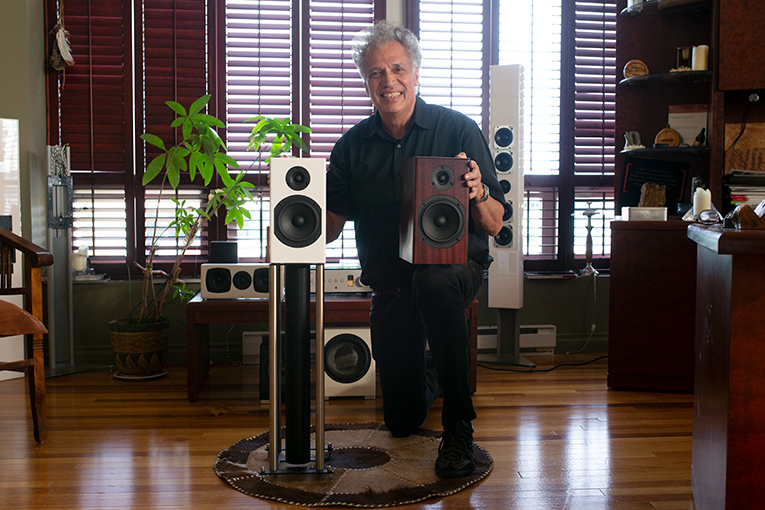 Vince Bruzzese with Satin White and Mahogany Skylights
Vince Bruzzese with Satin White and Mahogany Skylights
The panels of the Skylight’s MDF cabinet have lock-mitered joints, which are more complex to cut than standard mitered joints and which Bruzzese prefers for their greater strength. The finish options are a modern-looking Satin White matte paint, and two veneers of real wood: Black Ash and Mahogany, the latter a reddish color that Totem has used since their very first speaker, the Model 1, of 1987. Those veneers surprised me -- it’s rare to see real wood on a $1000/pair speaker, especially one made in Canada, where labor costs are high. Even so, these veneers are not available for Totem’s next model down in price, the Kin Monitor ($699/pair), which is made in China.
Because the Skylight is a finished design (and is now available to buy), Bruzzese was more eager to demonstrate it than talk about it. He took me to their headquarters’ biggest office (about 30’L x 15’W), where he’d set up a pair on a shelf along one long wall and hooked them up to Totem’s new Kin Amp ($695), a 100Wpc, class-D, Bluetooth-capable integrated amplifier designed to drive the Kin Monitor, which is even smaller than the Skylight. The speaker cables were what comes as standard kit with the Kin Amp. The office was full of Totem staffers -- they all stopped working and sat back in their chairs as Bruzzese began playing music from his smartphone via Bluetooth. At first the volume level was moderate -- but even when he turned it way up, the sound from the little Skylights remained clear and unstrained.
I wasn’t surprised to hear such small speakers fill so large a space with good sound -- I’d gotten over that long ago, with Totem’s Model 1, which wasn’t much bigger but could produce a sound whose size, all those years ago, did surprise me. The Skylight’s bass seemed pretty deep and punchy for so small a speaker, and that didn’t surprise me either -- not only had Bruzzese set them up only inches from the wall behind them, which of course boosted the bass, but also because, over the years, I’ve heard many Totem minimonitors produce amounts of deep, punchy bass that belied their small sizes. Big sound and big bass from small speakers seems to have been a Bruzzese thing from the start.
What sold me on the Skylights was how smooth they sounded in the midrange and high frequencies, the latter having an almost feathery lightness that I really liked. At that moment, I knew I wanted to take a pair home with me, and the natural choice of finish was that Mahogany veneer -- if you’re going to write and publish a review of a Totem Acoustic speaker that will include a photo of the review samples, you might as well pick the finish that has been identified with the company from its very first model.
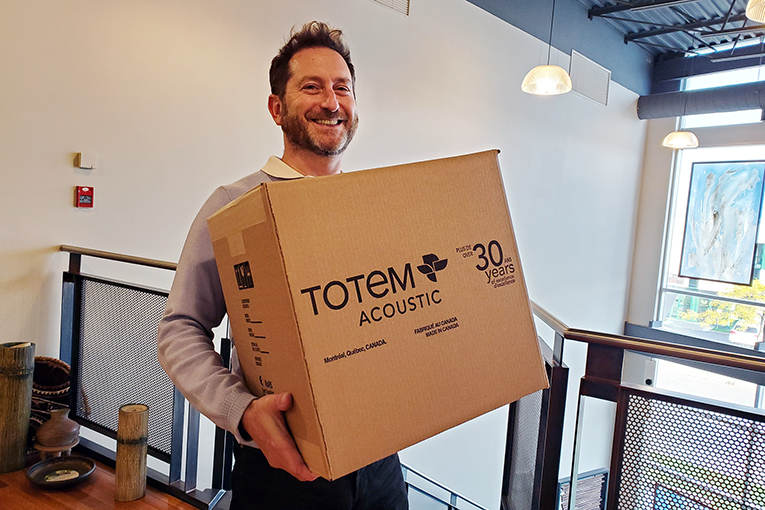 Totem’s Jason Zidle handing off a pair of Skylights
Totem’s Jason Zidle handing off a pair of Skylights
At home
I set up the Totem Skylights in my System One, on the 24”-high Monoprice Monolith stands ($109.98/pair) mentioned above. But instead of snugging the speakers up against the wall, as Vince Bruzzese had, their rear panels were 20” from the front wall. Not only did I want to hear just how bassy these little speakers could get on their own, with a lot less room gain; I’ve found that speakers image better, and produce a more open sound, when they’re at least 1’ from the wall behind them.
I drove the Totems with a Schiit Audio Ragnarok 2 integrated amplifier ($1499, or $1799 for the version I have, with built-in DAC and phono stage), which can produce 60Wpc into the Skylight’s nominal impedance of 8 ohms. (I didn’t use my Ragnarok 2’s DAC because it has only a single USB connection, and System One lacks a computer -- for now.) The speaker cables were QED XT25s ($84.99/2m pair), which I wrote about last October. The Ragnarok 2 was fed by Schiit’s Bifrost 2 DAC ($699) via J&D balanced (XLR) interconnects (approximately $20/1m pair). A Google Chromecast Audio streamer ($35 when available, plus $15 for the TosLink interconnect) fed digital signals to the Bifrost 2’s optical input, and I controlled playback with my Samsung Galaxy S10 smartphone. I played LPs on a Pro-Ject Audio Systems X1 turntable ($899) connected to the Ragnarok 2’s phono stage with the X1’s stock phono cable. System One is set up along one short wall of my living room, which measures 19’L x 15’W by 8’H.
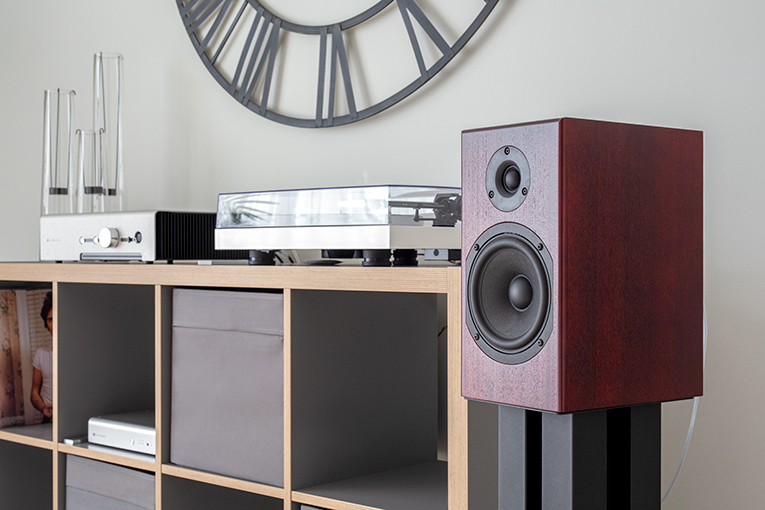
To test the Skylights’ bass and output capabilities, I streamed “Rolling in the Deep,” from Adele’s 21 (16-bit/44.1kHz FLAC, XL Recordings/Tidal). When the kick drum enters at 0:23, I usually want to turn the volume up and up, as you would when playing a Rolling Stones song at a party. But that’s when most small speakers begin to distort and/or compress the sound. The diminutive Totem Skylights did eventually begin to compress Adele’s voice, which started to sound hollow -- but by that point I’d set the volume level even higher than Bruzzese had in that big office at Totem -- at a level far higher than what I consider reasonable for speakers so small. It was clear: While best suited to small rooms, the little Skylights could put out enough sound to fill bigger spaces.
I also used “Rolling in the Deep” to test the impact on the sound of the Skylights’ grilles. This was easy to do -- the grilles attach to the speakers magnetically, and it takes no time at all to remove them or put them in place. Left on, they didn’t affect the bass, but they had a detrimental effect on the mids and highs -- Adele’s voice didn’t sound as open, and the highs in general weren’t quite as sweet and airy. Looking at the inside of one grille and seeing the hard-edged cutout around where the drivers are, I knew diffraction from the grilles was the likely culprit. I left the grilles off.
Next came “Bad Guy,” from Billie Eilish’s When We All Fall Asleep, Where Do We Go? (16/44.1 FLAC, Darkroom/Interscope), which won four 2019 Grammys, including one for Best Engineered Album, Non-Classical. This album’s woofer-torturing electronic bass not only goes deep, it’s prominent in the mix, and therefore can easily stress and possibly bottom out a speaker’s woofers at high volume. Playing the track at what I considered a “normal” level at home for music of this type -- fairly loud, but not party loud -- the Skylights pounded out bass powerfully and cleanly, never sounding strained. Unless you’re going to play recordings of pipe organ or EDM, with frequencies down in the bottom octave of the audioband (20-40Hz), the Skylights’ low-end response went deep and powerful enough to produce a full sound without the assistance of a subwoofer. I guesstimate that the Skylights produced decent output in my room down to 60 or 70Hz before the bass fell off a cliff. It seemed that the Skylight’s upper bass was prominent and strong enough to produce bass that I found quite satisfying, especially considering the speakers’ small size.
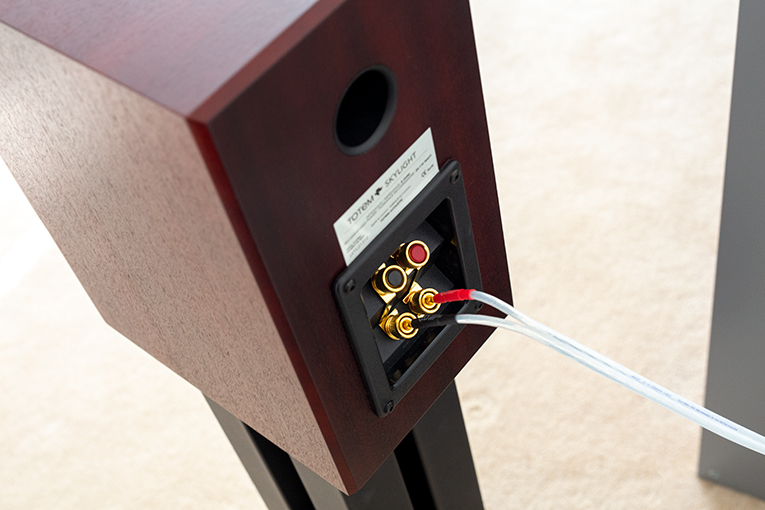
Hearing “Lovely” (16/44.1 FLAC single, Darkroom/Interscope), a beautiful-sounding duet that Eilish and Khalid recorded for season 2 of the Netflix series 13 Reasons Why, reminded me of KEF’s LS50 minimonitor ($1500/pair). I can’t say that the Totems sounded just like the KEFs -- it’s been years since I reviewed the LS50s. Rather, both models reproduced the sounds of voices with such natural ease and so much detail that it was easy for me to forget their small sizes and relatively low prices.
Another thing the Skylight had in common with the LS50 was how it highlighted its sonic strengths in a way that persuaded me to overlook its weaknesses. Neither speaker can produce deep bass, but their upper-bass responses are so full and their midranges so clear that it didn’t take long for my ears and brain to ignore the absence of the audioband’s lowest octave and a half. When such compromises are so well concealed, I know I’m hearing a well-designed speaker.
The Totem Skylights stumbled a bit over my favorite album of 2019, Lana Del Rey’s profanity-laced, achingly beautiful Norman Fucking Rockwell! (16/44.1 FLAC, Polydor). I know from listening to it again and again through my extraordinarily resolving, $100,000+ reference system that, throughout this album, Del Rey’s piano and, in particular, her voice, have a subtly but consistently glary sound. That glare was much more audible through the Skylights in System One, whether I listened at a low or a high volume. This was not only irritating, it obscured midrange details. But as I discovered, the cause was rooted mostly in my system.
Del Rey’s voice and piano in the title track were exciting some resonances, because the speaker was vibrating more than I thought it should -- and those vibrations were traveling into the stand, causing it to resonate, too. It was as if the glare constituted precisely the same frequency as the resonant frequency of the speaker-stand combo, which made this album’s already glary sound even more so.
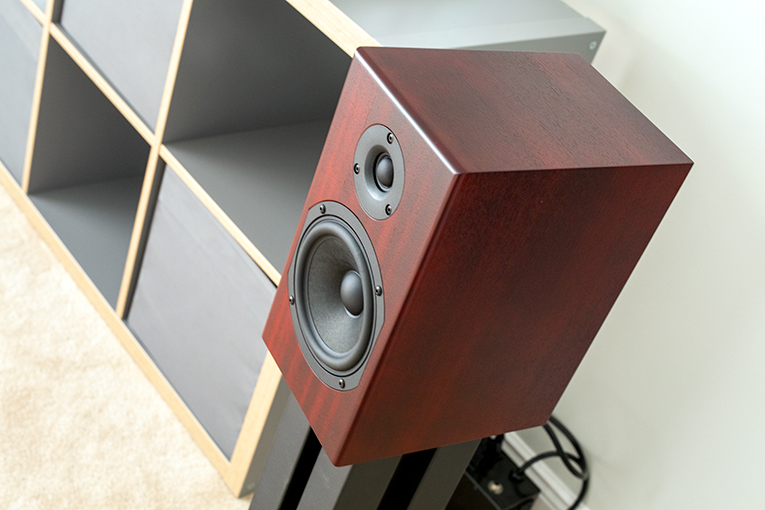
I lifted one Skylight from its stand, then lifted the stand itself, which felt twice as heavy as the speaker, and surmised that setting something so light on something so heavy would cause a lot of vibration unless I could find a way to tightly clamp them to each other. I also knew that the four little foam discs on the top of each stand weren’t doing anything to absorb resonances; about the only thing they were good for was keeping the speakers from being scratched by the stand.
Not about to drill holes through the top of each stand and use screws to secure the speakers, I spent less than $5 on some UHU tac adhesive putty (basically the same as Blu Tack). I rolled up eight little balls of UHU tac and stuck one atop each foam disc on each stand. I then set each Skylight atop the UHU-dotted foam and pushed it down hard, to ensure that it was stuck fast to the stand. (You can view a one-minute video I shot of this process on our Instagram page.) For a secure but still temporary attachment that provides a good bit of resonance damping, UHU tac does a bang-up job. When I played “NFR!” again, I still heard a bit of upper-midrange peakiness, but I think that’s inherent in the speaker’s voicing. What was most important was that the excessive glare was mostly gone.
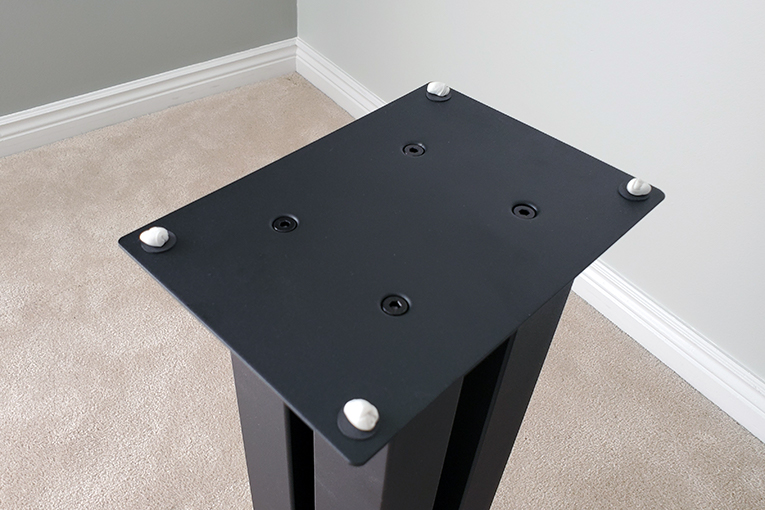
Norman Fucking Rockwell! now sounded more the way I like it, which confirmed something I’d noticed at Totem’s office: a pair of Skylights could sound bigger not only because of their relatively deep, quite punchy bass, but also because their drivers and enclosures disperse sound that creates a very immersive soundfield.
I completed my critical listening with some vinyl, which I considered mandatory. Vince Bruzzese demonstrated the Skylights via Bluetooth, but he’s no digital guy -- he’s told me often that he does his most critical listening with vinyl.
I began with Bob Seger’s Against the Wind (LP, Capitol SOO-12041), an album I like for its music but not its sound quality. The sound is not particularly clear, the dynamics are stunted, and both of my copies, pressed at the same plant in the same year, are in poor shape -- I have to listen through lots of surface noise. The Skylights didn’t obscure details, but readily revealed all the problems on these discs.
I quickly moved on to side 2 of Bruce Springsteen’s Tunnel of Love. With all levels matched and good source components, the LP (Columbia COC 40999), the CD (Columbia CK 40999), and the Tidal stream all sound pretty much identical -- at best, I hear only subtle differences. I began playing the LP and, a few seconds later, the Tidal stream, then switched back and forth to compare their sounds through the Skylights.
As I’ve consistently heard before in comparisons of Tidal streams to other vinyl sources, the bass sounded slightly deeper and a little punchier, Springsteen’s voice more dynamic and forward. The LP countered with sweeter highs, a more relaxed sound overall, and a bit more spaciousness. But did one format sound better than the other? I thought it a draw, but my 13-year-old son, who was right there the whole time, disagreed. When I got three cuts in, to “Brilliant Disguise,” he blurted out, “The record sounds smoother.” And I had to admit that it did, especially through the midrange, which sounded a little shouty at times via the streamed digital feed. The digital stream’s punchier bass could also slightly overpower higher frequencies and thus obscure some details. In “One Step Up,” backing singer Patti Scialfa’s entrance was a bit more apparent through the LP. But that’s neither here nor there when it came to the speakers themselves -- they and the rest of the components were simply passing along the differences between the recordings and the source components they were being played back on. Bruzzese might voice using vinyl, but whichever format you prefer, these speakers will let its vices and virtues be heard.
Conclusion
The Skylight is an entry-level product in Totem Acoustic’s line, along with their Kin Monitor speaker, though the Kin is less an audiophile component than one of their lifestyle products. Totem is not in a race to the bottom to make the world’s least-expensive speakers, but a company whose founder still designs its products and makes them sound just as he wants them to sound, and that produces speakers like the Skylight in their Montreal facility using artisanal craftsmanship rather than an assembly line -- I know because I’ve been there and seen it. As a result, though Totem now produces enormous numbers of speakers that they ship all over the world, they still operate like a specialized, boutique operation -- and when you buy one of their speakers, that’s the kind of product you get.
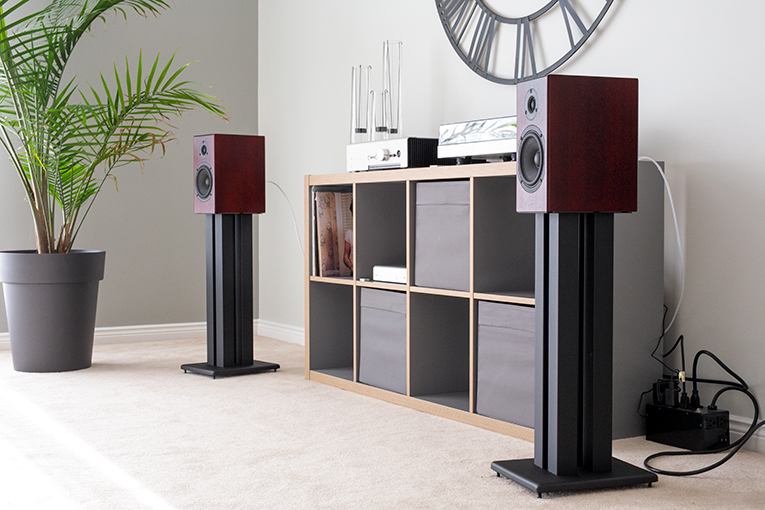
But outside the world of audiophilia, $1000 is still a lot of money to pay for a pair of speakers, and such a price needs to be justified in the ears and eyes of the prospective buyer. The Totem Skylight justifies its price. Under the real-wood veneer and the high build quality, both of which are themselves admirable for the price, is a speaker with a distinctive voice that’s really appealing to listen to: ample, punchy bass that belies the speaker’s size; a naturalness and ease that permeate the midband and highs; and a spacious sound that helps you forget that it’s being produced by a pair of little boxes. In those ways, the Skylight is a lot like Totem’s Model 1: a small but mighty overachiever for those who don’t have a lot of money to spend on speakers or a big space to put them in -- or either of those things.
I liked the Skylight a lot. I think it’s the best-value speaker Totem Acoustic has offered in years. I can see it as the first of many Totem models someone might buy: the very definition of entry level. And for someone who loves the Skylight’s sound just as it is, it could be the last Totem they buy for a very long time -- or the last speaker they ever buy. Period.
. . . Doug Schneider
das@soundstagenetwork.com






















